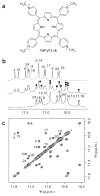Small-molecule interaction with a five-guanine-tract G-quadruplex structure from the human MYC promoter
- PMID: 16408022
- PMCID: PMC4690526
- DOI: 10.1038/nchembio723
Small-molecule interaction with a five-guanine-tract G-quadruplex structure from the human MYC promoter
Erratum in
- Nat Chem Biol. 2005 Sep;1(4):234
Abstract
It has been widely accepted that DNA can adopt other biologically relevant structures beside the Watson-Crick double helix. One recent important example is the guanine-quadruplex (G-quadruplex) structure formed by guanine tracts found in the MYC (or c-myc) promoter region, which regulates the transcription of the MYC oncogene. Stabilization of this G-quadruplex by ligands, such as the cationic porphyrin TMPyP4, decreases the transcriptional level of MYC. Here, we report the first structure of a DNA fragment containing five guanine tracts from this region. An unusual G-quadruplex fold, which was derived from NMR restraints using unambiguous model-independent resonance assignment approaches, involves a core of three stacked guanine tetrads formed by four parallel guanine tracts with all anti guanines and a snapback 3'-end syn guanine. We have determined the structure of the complex formed between this G-quadruplex and TMPyP4. This structural information, combined with details of small-molecule interaction, provides a platform for the design of anticancer drugs targeting multi-guanine-tract sequences that are found in the MYC and other oncogenic promoters, as well as in telomeres.
Conflict of interest statement
COMPETING INTERESTS STATEMENT
The authors declare that they have no competing financial interests.
Figures





Similar articles
-
Design and synthesis of an expanded porphyrin that has selectivity for the c-MYC G-quadruplex structure.J Am Chem Soc. 2005 Mar 9;127(9):2944-59. doi: 10.1021/ja0444482. J Am Chem Soc. 2005. PMID: 15740131
-
DNA G-Quadruplex in Human Telomeres and Oncogene Promoters: Structures, Functions, and Small Molecule Targeting.Acc Chem Res. 2022 Sep 20;55(18):2628-2646. doi: 10.1021/acs.accounts.2c00337. Epub 2022 Sep 2. Acc Chem Res. 2022. PMID: 36054116 Free PMC article.
-
Solution structure of the biologically relevant G-quadruplex element in the human c-MYC promoter. Implications for G-quadruplex stabilization.Biochemistry. 2005 Feb 15;44(6):2048-58. doi: 10.1021/bi048242p. Biochemistry. 2005. PMID: 15697230
-
Drug targeting of the c-MYC promoter to repress gene expression via a G-quadruplex silencer element.Semin Oncol. 2006 Aug;33(4):498-512. doi: 10.1053/j.seminoncol.2006.04.012. Semin Oncol. 2006. PMID: 16890804 Review.
-
Structure of the biologically relevant G-quadruplex in the c-MYC promoter.Nucleosides Nucleotides Nucleic Acids. 2006;25(8):951-68. doi: 10.1080/15257770600809913. Nucleosides Nucleotides Nucleic Acids. 2006. PMID: 16901825 Review.
Cited by
-
The formation and stabilization of a novel G-quadruplex in the 5'-flanking region of the relaxin gene.PLoS One. 2012;7(2):e31201. doi: 10.1371/journal.pone.0031201. Epub 2012 Feb 21. PLoS One. 2012. PMID: 22363579 Free PMC article.
-
Modulation of DNA structure formation using small molecules.Biochim Biophys Acta Mol Cell Res. 2019 Dec;1866(12):118539. doi: 10.1016/j.bbamcr.2019.118539. Epub 2019 Sep 3. Biochim Biophys Acta Mol Cell Res. 2019. PMID: 31491448 Free PMC article. Review.
-
In Silico Screening and Binding Characterization of Small Molecules toward a G-Quadruplex Structure Formed in the Promoter Region of c-MYC Oncogene.ACS Omega. 2017 Aug 31;2(8):4382-4397. doi: 10.1021/acsomega.6b00531. Epub 2017 Aug 9. ACS Omega. 2017. PMID: 30023722 Free PMC article.
-
Subtle structural alterations in G-quadruplex DNA regulate site specificity of fluorescence light-up probes.Nucleic Acids Res. 2020 Feb 20;48(3):1108-1119. doi: 10.1093/nar/gkz1205. Nucleic Acids Res. 2020. PMID: 31912160 Free PMC article.
-
Stabilization of a G-Quadruplex from Unfolding by Replication Protein A Using Potassium and the Porphyrin TMPyP4.J Nucleic Acids. 2011;2011:529828. doi: 10.4061/2011/529828. Epub 2011 Jun 16. J Nucleic Acids. 2011. PMID: 21772995 Free PMC article.
References
-
- Marcu KB, Bossone SA, Patel AJ. myc function and regulation. Annu Rev Biochem. 1992;61:809–860. - PubMed
-
- Pelengaris S, Rudolph B, Littlewood T. Action of Myc in vivo—proliferation and apoptosis. Curr Opin Genet Dev. 2000;10:100–105. - PubMed
-
- Jaattela M. Multiple cell death pathways as regulators of tumour initiation and progression. Oncogene. 2004;23:2746–2756. - PubMed
-
- Slamon DJ, deKernion JB, Verma IM, Cline MJ. Expression of cellular oncogenes in human malignancies. Science. 1984;224:256–262. - PubMed
Publication types
MeSH terms
Substances
Associated data
Grants and funding
LinkOut - more resources
Full Text Sources
Other Literature Sources
Miscellaneous

